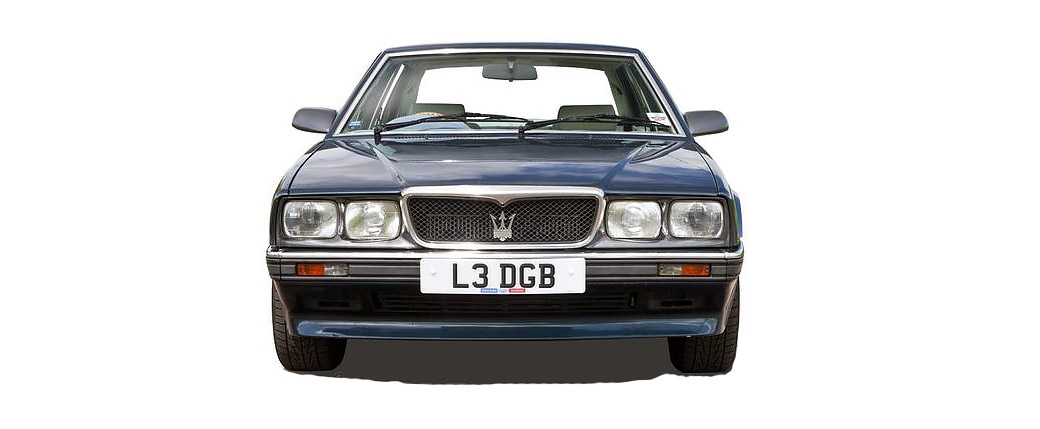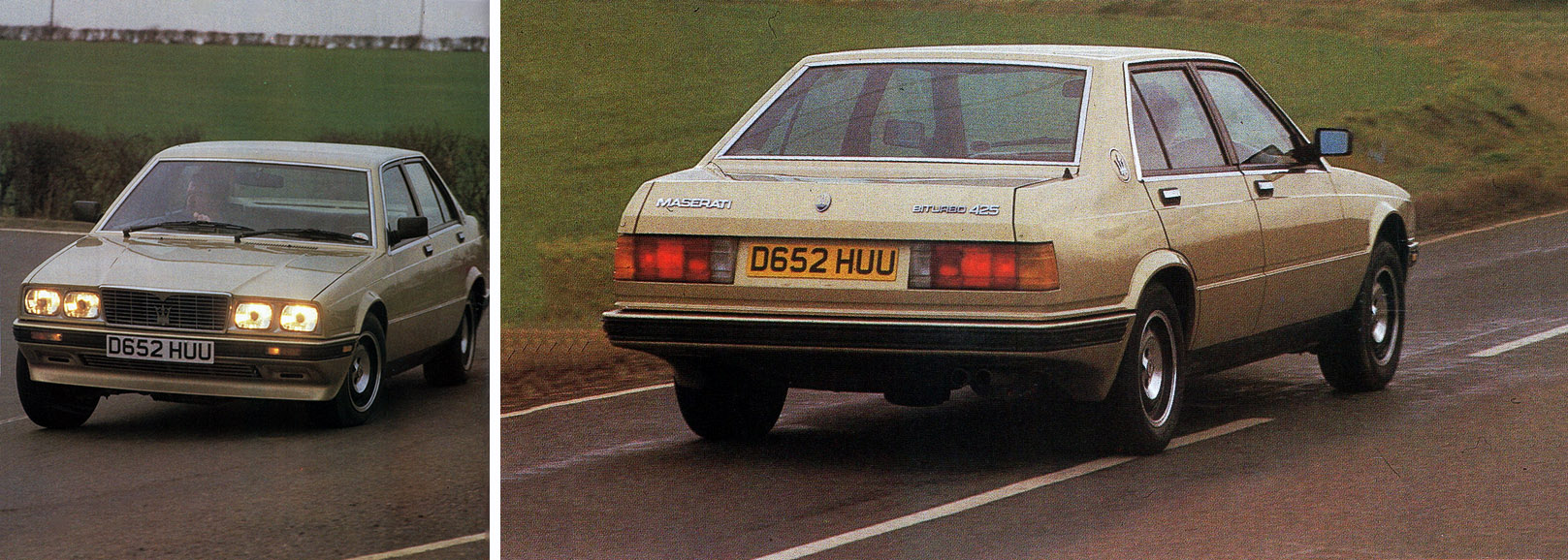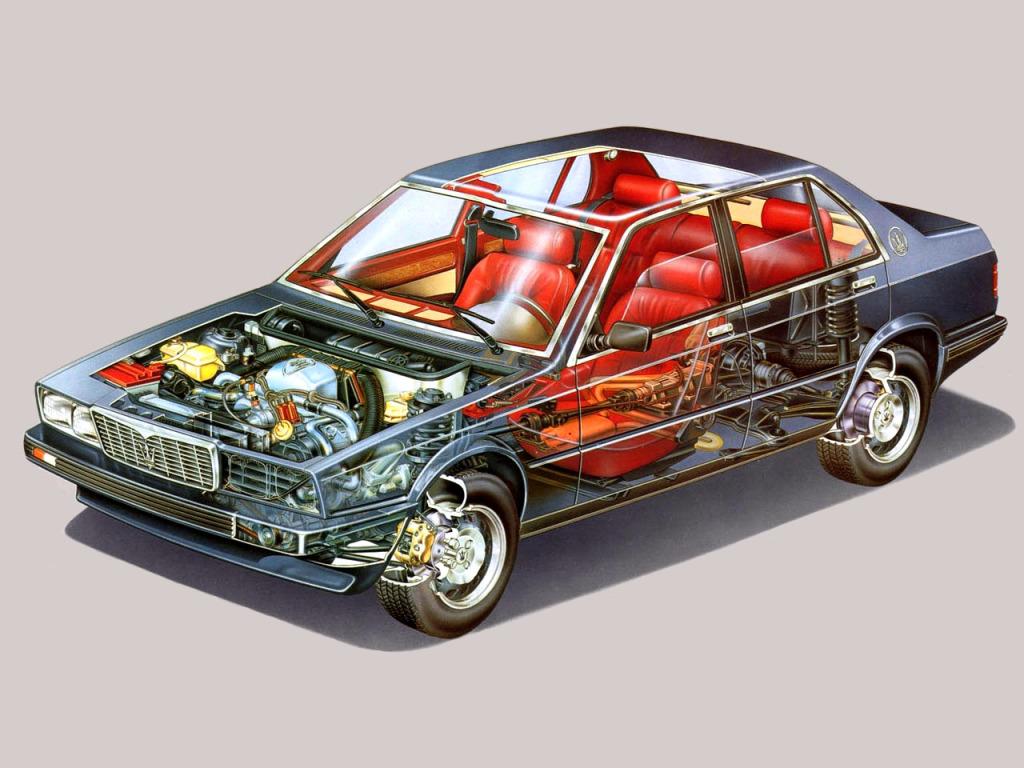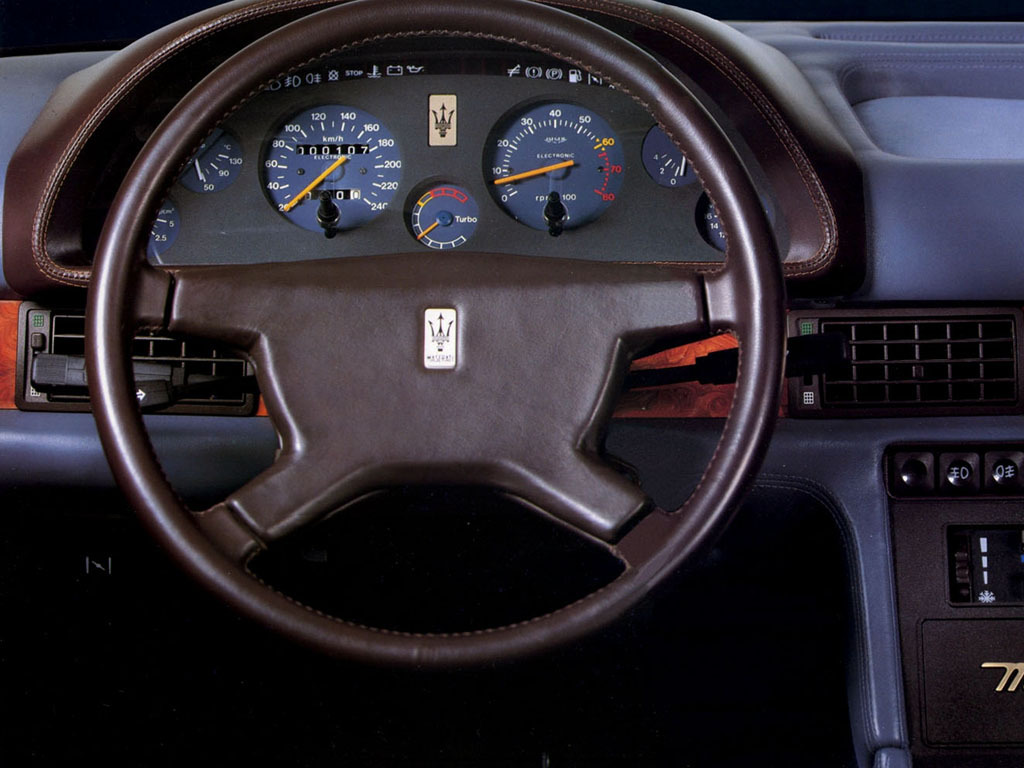
The long wait is over for British Maserati enthusiasts, but the car that was built to take on BMW’s 3-Series E30 now has a supercar price tag Rich man’s Alfa, or family man’s Ferrari? We test the four-door 425.
Characterful Maserati saloon finally comes to Britain carrying a supercar price tag. Twin-turbo V6 gives strong mid-range punch, but economy is disastrous. The Biturbo rides smoothly, but normally tidy handling deteriorates badly in the wet, brakes are powerful but lack ABS. Cabin is roomy, comfortable and trimmed in the finest materials, but finish isn’t perfect and some equipment items are missing. Exclusive, but the price is too high.
The Trident badge is back – but it’s taken six years for the Maserati Biturbo to come to Britain. Three versions – coupe, spyder and four-door, saloon – are being imported by the newly formed Maserati (UK) Ltd, all flaunting Latin style and the magic of the Maserati name for Jaguar/Mercedes money. Priced at £27,795 (1987), the 425 is closely based on the original Biturbo Coupe – which sells for £3000 less – but gains an extra 25 cm (9.7 in) body length and more power (but curiously, less torque) from its twin turbo-charged 2.5-litre V6 engine.
In size, the subtly-styled Modenese saloon is fractionally smaller than a Mercedes 190 W201, though bigger than a E30 3-Series BMW. But thanks to the inherent compactness of its powertrain, sensible packaging and blunt extremities, it’s much more roomy than either of these cars – and considerably more so than the shorter-wheelbase Biturbo Coupe.

Neither the Mercedes 190 2.3-16 W201 or the BMW 325i E30 can be considered limp-wristed, but the Biturbo is more powerful than either: with outputs of 196 bhp (at 5600 rpm), and 205 lb ft (at 4000 rpm) respectively for power and torque, the Maserati’s twin-turbo V6 is clearly in a different league from its rivals’ power units; its specification, too, is unique.
The steel-linered aluminium V6 engine’s 90° vee angle, heavily oversquare (91.6×63.0 mm) cylinder dimensions, 7.4:1 compression ratio and single belt-driven overhead camshaft are rather mundane by Italian supercar standards. But the Biturbo features three valves per cylinder (two intake, one exhaust), and twin Japanese IHI watercooled turbochargers pressurising the induction sys-tem at 0:8 bar (12 psi) – twin low-inertia turbos reduce throttle lag, and make for simplified plumbing arrangements with a V6 engine.

Surprisingly, though, fuelling is by means of a single pressure-enclosed Weber carburetter rather than injection, and there is no intercooling. The rest of the mechanical specification holds no surprises. Drive is to the rear wheels through ZF five-speed manual (or optional ZF automatic) transmission and Maserati Sensitork (Torsen) limited-slip differential. Power-assisted rack-and-pinion steering is used, disc brakes feature at both ends and, as on the E30 BMW 3-Series, the all-independent suspension is by front MacPherson struts and rear trailing arms. The 425 (comes with 6 ½ J alloy wheels, shod with 205/60 VR14 Michelin MXV tyres.

According to the brochure, the Biturbo will top 140 mph, and accelerate from 0-62 mph in just 6.6 sec. But Motor’s fifth wheel failed to substantiate these claims. In good testing conditions, the Maserati reached a rev-limited 131.2 mph maximum speed in fourth gear, but fifth gave no more than 127.3 mph. All but one of the selected rivals have higher maxima, and even the Audi is close, with 130.8 mph.
Aided by good traction and slick gearshift, the benchmark 0-60 mph sprint takes 7.0 sec, making the Maserati more accelerative than the Mercedes (7.4 sec) and not far adrift of the more powerful BMW (6.9 sec). Again though, it’s well short of Maserati’s claim.
The torque peak occurs at a heady 4000 rpm, suggesting that the real urge is concentrated well up in the rev range. But while this is largely true, flexibility is good by turbo standards. The Biturbo’s 7.7 sec fourth gear 30-50 mph time betters those of the Audi (8.2 sec) Lotus (8.4 sec) and Mercedes (7.8 sec), and is within a tenth of the BMW’s time.
Like most turbocharged engines, that of the Maserati is strongest in the upper midrange. Thus the speed range times diminish as the car gets faster – the 50-70 mph increment is coincidentally the quickest one both in fourth and fifth gears (6.1 and 9.4 sec respectively).

But while the engine responds with more vigour beyond about 3000 rpm, there’s no uncouth rush of power as in some turbos, or noticeable lag in throttle response. Retention of a twin-choke carburetter does bring about com-promises, though: snap-throttle openings reveal serious flat-spots, while our test car also suffered from bouts of stalling and poor hot-starting. Clearly, no one buys a Maserati for its fuel economy, and that’s just as well. Our 15.5 mpg overall consumption almost defies belief considering the Biturbo’s size, weight and performance. Even allowing for the generous 80-litre (17.6-gal) tank size, the range is likely to be no more than 375 miles.
| FUEL CONSUMPTION | ||
| Overall | 15.5 mpg 18.2 litres/100 km | |
| Touring* | 21.3 mpg 13.3 litres/100 km | |
| Govt tests | 16.1 mpg (urban) 30.3 mpg (56 mph) 22.6 mpg (75 mph) | |
| Fuel grade | 97 octane | |
| 4 star rating | ||
| Tank capacity | 80 litres | |
| 17.6 galls | ||
| Max range* | 375 miles | |
| 603 km | ||
| Test distance | 1002 miles 1612 km | |
| Based on official fuel economy figures – 50 per cent of urban cycle, plus 25 per cent of each of 56/75 mph consumptions. | ||
| STEERING | ||
| Turning circle Lock to lock | 11.6 m 38.0 ft 3.5 turns | |
| NOISE | dBA | |
| 30 mph | 66 | |
| 50 mph | 69 | |
| 70 mph | 73 | |
| Maximumt | 79 | |
| Peak noise level under full-throttle acceleration in 2nd | ||
| SPEEDOMETER (MPH) | ||
| True mph 30 40 50 60 70 80 90 100 | ||
| Speedo 30 40 50 60 70 80 90 100 | ||
| Distance recorder: 2.4 per cent slow | ||
| WEIGHT | kq | cwt |
| Unladen weight* | 1240 | 24.4 |
| Weight as tested | 1460 | 28.7 |
| *No fuel | ||
| Performance tests carried out by Drive-My staff at the Drive-My Industry Research Association proving ground, Lindley, and Millbrook proving ground, near Ampthill. | ||
| Test Data: World Copyright reserved. No reproduction in whole or part without written permission. | ||
The ZF gearbox has its shift pattern arranged with a dogleg first gear and the remaining, most frequently used gears together in an “H” with a lever bias towards the second/third plane. The movements feel very short and direct, but as a corollary, there’s unwelcome vibration felt through the wood-capped lever. The ratios are sportingly close, with fifth gear pulling 26.2 mph/1000 rpm.
Although earlier versions managed without it, all current Biturbos have power steering. It makes for considerably easier low-speed manoeuvring, but robs the driver of some communication. The steering is low-geared and has a rather woolly feel, making it difficult to detect the considerable build-up of understeer when cornering hard. Cornering grip is good in the dry, and the rear semi-trailing arm suspension is mild-mannered: only the most brutal second gear power applications send the tail scurrying, while mid-corner lift-off results in only gentle tightening of the cornering line. The handling may be tame, but it lacks the tautness expected from a thoroughbred. Somehow, it doesn’t encourage its driver to push it.
On a wet road, the reasons for this are brought into sharper focus. Understeer builds up very strongly under gentle power, but more throttle quells this with alarming speed to the extent that the tail will break away. It’s not so vicious that it can’t be caught, but the steering’s slow-ness of response, and the difficulty – characteristic of a turbo-charged car – of modulating precisely the power to the driving wheels, make it a task calling for some precision.
The danger is that once you have sorted out the slide, you continue round the bend at a more gentle pace to be confronted with massive understeer again. There seems to be no neutral phase, just an “over centre” feel to the handling as it flicks from one extreme to the other. The natural tendency is for the rear wheels to lose their grip first, but this is quelled by artificially-induced understerer, designed to try and make the car feel stable.
The Maserati rides comfortably, though, and for the 425, this is arguably more important. Considering its sporting origins, the Biturbo is quite softly sprung. It’s not quite in the Jaguar class, but certainly the Italian has a suppleness that you won’t find in a sporting Audi or BMW. Aside from a little free pedal play, the powerful brakes are well up to the task of arresting the Maserati. But the handbrake – which is meant to work on auxiliary rear drums – is an unmitigated disaster, incapable of resisting even the slightest gradient. Later cars will have an ABS option.
If the Biturbo’s understated and now rather dated exterior fails to distinguish it from cheaper less exalted rivals, no such accusations can be made about the interior. Hand trimmed in (optional) leather and walnut, the cabin oozes opulence. It’s roomy, too, giving few inches away to BMW’s larger-bodied 5-Series E28 for passenger space; and it’s blessed with a decent-sized boot.
| PERFORMANCE | ||
| WEATHER CONDITIONS | ||
| Wind 6 mph | ||
| Temperature 52 deg F/11 deg С | ||
| Barometer 30.0 in Hg/1016mbar | ||
| Surface Dry tarmacadam | ||
| MAXIMUM SPEEDS |
||
| mph | kph | |
| Banked Circuit (4th gear) | 131.2 | 211.1 |
| Best ¼ mile (4th gear) | 131.7 | 211.9 |
| Max speed in (5th gear) | 127.3 | 204.9 |
| Terminal speeds | ||
| at ¼ mile | 90 | 145 |
| at kilometre | 111 | 179 |
| Speeds in gears (at 6400 rpm): | ||
| 1st | 39 | 62 |
| 2nd | 68 | 110 |
| 3rd | 95 | 153 |
The seats have a multiplicity of electric adjustments, so getting comfortable at the wheel ought not to be a problem. But some testers complained that the otherwise comfortable Squashy seats were ruined by protrusions at shoulder level.
The driving position is much better than, say, an Alfa 75’s; the major controls are positioned about right – though the small, leather-bound steering wheel only adjusts for height – and the pedals allow easy heel and toe action.
But there are omissions which reflect the age of the design and the fact that it is produced by a small specialist maker ;the mirrors adjust manually, there’s no flick-wipe or variable intermittent setting for the wipers; don’t expect a trip computer, or cruise control either.
Although the Maserati boasts air conditioning, there are snags with the heating and ventilation system. The temperature slider is stiff and imprecise, while the push-button distribution controls give rather inflexible metering.
There’s a good selection of small blue-faced instruments neatly presented behind a BMW-style series E12-E34 binaccle. They include an uncalibrated turbo boost gauge and notably accurate speedometer. Nestling in the middle of the walnut veneer facia, there’s what appears to be a gold-edged wrist watch.
From the outside, the Biturbo is pleasingly free of adornment, while the paint finish is deep and lustrous and panel seams nicely leaded. But there are some disappointing aspects to the finish; some panel fits are poor, and on our test car there was corrosion around the stainless steel windscreen trim.
The interior isn’t perfect, either. The heater control panel looks cheap and is mounted slightly askew, the gearlever gaiter doesn’t close up around the’ lever, and none of our testers liked the ”Beige Nuvolato” orangey-tan trim.
Distinctive touches abound; the wooden gear knob, the trident symbols everywhere, and the beautiful leather wallet containing the (English) handbook and service documents – encouragingly it shows that Maserati are taking the UK market seriously. (For the moment, the aim is to sell 400 Biturbos a year, through 30 new Maserati dealers).
| ACCELERATION FROM REST | |||
| mph | sec | kph | sec |
| 0-30 | 2.4 | 0-40 | 2.1 |
| 0-40 | 3.5 | 0-60 | 3.2 |
| 0-50 | 5.3 | 0-80 | 5.3 |
| 0-60 | 7.0 | 0-100 | 7.5 |
| 0-70 | 9.2 | 0-120 | 10.6 |
| 0-80 | 12.0 | 0-140 | 14.3 |
| 0-90 | 15.2 | 0-160 | 20.0 |
| 0-100 | 20.9 | 0-180 | 29.7 |
|
0-110 |
27.8 | Standing 1 km | 28.6 |
| Standing ¼ mile | 15.4 | ||
| ACCELERATION IN TOP | |||
| mph | sec | kph | sec |
| 20-40 | 14.4 | 40-60 | 8.5 |
| 30-50 | 12.9 | 60-80 | 7.8 |
| 40-60 | 11.2 | 80-100 | 6.1 |
| 50-70 | 9.4 | 100-120 | 5.8 |
| 60-80 | 9.5 | 120-140 | 7.1 |
| 70-90 | 11.6 | 140-160 | 9.3 |
| 80-100 | 13.8 | ||
| ACCELERATION IN 4TH | |||
| mph | sec | kph | sec |
| 20-40 | 9.4 | 40-60 | 5.8 |
| 30-50 | 7.7 | 60-80 | 4.4 |
| 40-60 | 6.4 | 80-100 | 3.7 |
| 50-70 | 6.1 | 100-120 | 4.2 |
| 60-80 | 6.7 | 120-140 | 4.7 |
| 70-90 | 7.3 | 140-160 | 5.4 |
| 80-100 | 8.3 | 160-180 | 7.8 |
| 90-110 | 10.8 | ||
But has it been worth the wait? As it stands, the Biturbo 425 faces something of an identity crisis. Viewed as an Italian BMW alternative, the £27,795 Biturbo 425 looks disturbingly expensive alongside a BMW M535i (£22,195) or Mercedes 190E 2.3-16 (£24,670). Really, it has to be judged as a four-door supercar – a cheaper, more accommodating alternative to a Ferrari Mondial 3.2 (£41,250). But it has to give best to the legendary Quattro (£27,124) for chassis ability and the Lotus Excel SE (£20,570) for sheer value.
Personality the Biturbo has in abundance; it’s exotic, luxurious and it makes a sound that will stir the heart of any enthusiast. And it has guaranteed exclusivity, as well as the magic of the Maserati name in its favour.
But the virtues are offset by too many vices – the flashes of brilliance are marred by faults: The disastrous fuel consumption. The indifferent wet weather roadholding. The host of detail flaws. Nor is it fast enough to make it as a real supercar. It simply doesn’t offer enough advantages over a BMW 325i E30 or Alfa-Romeo 75 to be worth twice the outlay. It’s a valiant effort, but it’s not for us.

Below, heart of the Biturbo is the 196 bhp 2.5-litre V6 engine; large central plenum chamber houses pressurised Weber downdraught carburetter.

Classic Italian instruments with central boost gauge. Good driving position, but soft leather seats-electrically adjustable in the front-don’t suit all tastes.

Blunt nose, crisp wedge-shaped lines characterise the Biturbo saloon (opposite). 425 body is 25 cm longer than original coupe. Right, ZF gearbox has dog-leg first, wood-capped lever; ineffectual handbrake is on the wrong side of the transmission tunnel.
AUDI QUATTRO £27,124
A more civilised machine these days than its epoch-making predecessor, the 4wd Quattro is more than ever a milestone in car design. It combines phenomenal roadholding and traction with performance, refinement, economy, comfort and accommodation in a way that has no equal, against which its weaknesses – poor ratios (still) and slow shift, unprogressive heating, sparse instruments – are minor failings. Now with anti-lock braking as standard.
BMW M535i E28 £22,195
M535i has all the right ingredients to make it a cut-price Alpina, but slips up dynamically with wet weather handling that is painfully reminiscent of old big-engined BMWs. On a more positive note, straight-line performance is terrific (though engine lacks crispness) and economy very fair. Usual 5-Series strengths: room, build, comfort. And at £22,195 the M535i E28 must rate as good value.
FERRARI MONDIAL 3.2 £47,250
Ferrari’s token four-seater has now inherited the super-smooth wailing 32-valve 3.2-litre V8 that powers the 328 GTB, and this should guarantee irresistable supercar performance and yet deliver reasonable, economy. Handling remains well balanced, the brakes are excellent and the ride supple. The driving position too is comfortable and the gearchange satisfying, if heavy. Minus points are high noise levels and idiosyncratic heating system.
LOTUS EXCEL SE £20,570
Fastest version of Excel yet is a superb driving machine with excellent outright performance but poor economy. Standards of handling and grip are better than ever, though ride has suffered with the adoption of lower profile tyres. Toyota gearbox is particularly impressive and interior trim is tastefully executed. The Excel still has too much the aura of a plastic car, however, for the £20,570 asking price.
MERCEDES BENZ 190E 2.3-16 W201 £24,670
The 2.3-16 has a lot to live up to in this company but falls down in some crucial areas; top speed is disappointing for price (albeit married to good economy), gearchange indifferent and accommodation no better than 2+2 despite four door. Plus points include wonderfully smooth and revable engine, matchless ride/handling and superb build and finish. Overall, a very appealing car but badly overpriced.
Other possible rivals include 1987 price:
BMW 735i E32 SE (£31,750)
Jaguar Sovereign 3.6 (£24,995)
Ford Sierra Cosworth (£17,000)
Saab Turbo SE (£22,495)
| Car | 1987 Maserati Biturbo 425 |
| Made in | Italy |
| ENGINE | |
| Cylinders | V6, 90° |
| Capacity | 2491 cc |
| Bore/Stroke | 91.6×63.0mm |
| Max power | 196 bhp (146 kW) at 5600 rpm (DIN) |
| Max torque | 205 lb ft (278 Nm) at 4000 rpm (DIN) |
| Block | Aluminium alloy |
| Head | Aluminium head |
| Cooling | Water Single |
| Valve gear | overhead camshaft, belt drive 3 valves/cylinder |
| Compression | 7.4:1 |
| fuel system | One double choke carburetter (Weber) twin watercooled IHI turbochargers |
| Ignition | Contactless |
| Bearings | 4 main |
| TRANSMISSION | |
| Drive | To rear wheels |
| Type | 5-speed manual ZF |
| Internal ratios and | mph/1000 rpm |
| Top | 0.79/26.2 |
| 4th | 1.00/20.7 |
| 3rd | 1.39/14.9 |
| 2nd | 1.94/10.7 |
| 1st | 3.42/6.1 |
| Rev | 3.66 |
| Final drive | 3.31 |
| SUSPENSION | |
| Front | MacPherson struts, lower arms, tie rods springs and anti-roll bar |
| Rear | Semi-trailing arms, coil springs |
| STEERING | |
| Type | Rack and pinion |
| Assistance | yes, Bosch |
| BRAKES | |
| Front | Discs, 28.2mm dia |
| Rear | Discs, 27.2mm dia |
| Servo | Yes |
| Circuit | Split front/rear |
| Rear valve | No |
| WHEELS/TYRES | |
| Type | Alloy, 6 ½ Jx14in. dia. |
| Tyres | Size, 205/60 VR14 Make, Michelin MXV |
| Pressures F/R (normal) | 30/28 psi 2.1/1.9 bar |
| ELECTRICAL | |
| Battery | 12 V, 60 Ah |
| Alternator | 65 Amp |
| Fuses | 14 |
| Headlights | Halogen |
| type | 110 W total |
| dip | 240 W total |
| main | |
| GUARANTEE | |
| Duration | One year unlimited mileage; two years for major mechanical components |
| Rust warranty | 6 years |
| MAINTENANCE | |
| Major service | 6000 miles |
| Intermediate service | 12000 miles |





